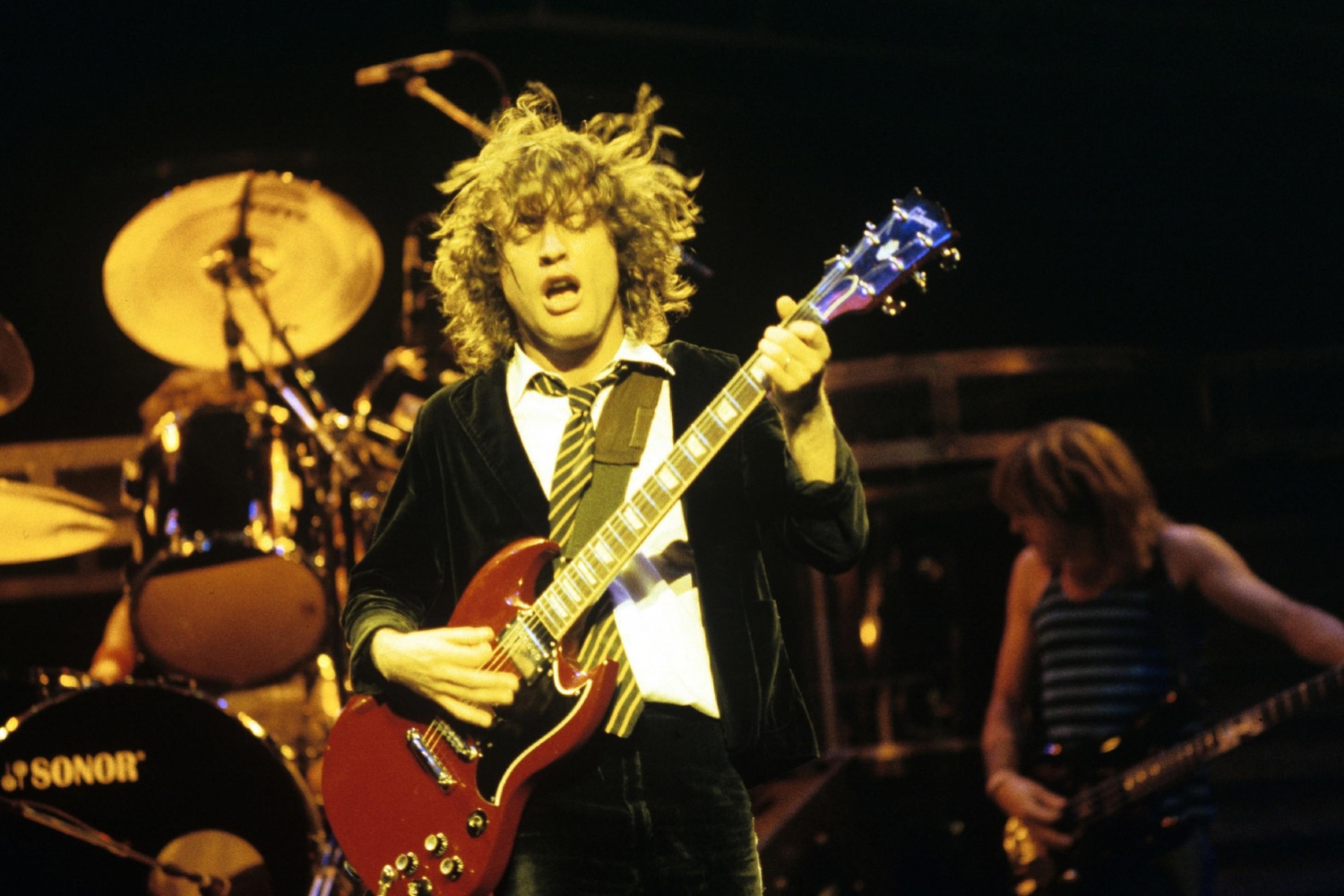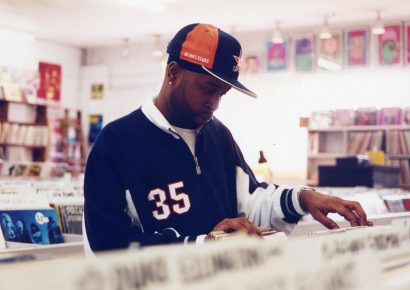From Angus and Tony to Sister Rosetta Tharpe and beyond, we explore the story of Gibson's best-selling double-cut.
Few guitars have proven to be as pivotal to the evolution of rock ‘n roll as that of the Gibson SG. Introduced to the market in 1961 as a means of recouping sales after the popularity of the Les Paul began to wane, the SG (standing for Solid Guitar) marked a significant departure from the design of the company’s single-cut classic, becoming an immediate hit with players and quickly asserting its niche as a go-to guitar for rock and blues guitarists of the era.
Gibson SG
In many respects, the SG was considered to be a successor to the Les Paul upon launch, and when glancing upon the spec sheet of the original design, it’s easy to see why. It was sleeker, lighter and far more ergonomic than the Les Paul thanks to some cleverly designed contours and its iconic double-cut construction, yet still provided players with the beefy tonality and versatility they’d come to expect from the Gibson name.
Although the Les Paul would experience a mighty comeback in the years that followed the release of the SG, the distinctive double-cut guitar has never lost traction over the years, and to this day, it’s the only electric model in Gibson’s catalogue to remain in constant production.
We’re diving back through the annals to examine ten of the most iconic guitarists to ever play a Gibson SG, examining their musical impact and how the SG has facilitated their playing style over the years to assert its status as one of the most crucial tools in the development of rock music today.
Read up on all the latest features and columns here.
Angus Young
Is there any guitarist more synonymous with Gibson’s famous double-cut electric than Angus Young? For the best part of 50 years, Young has cycled through countless SGs for use onstage and in the studio with AC/DC, and began his love affair with the instrument in 1971 when he purchased his primary model – a ’60s Vibrola-equipped variant with an unusually thin neck – from a guitar store in Sydney.
As time passed and AC/DC rose to become global rock heavyweights, Young’s relationship with the SG was only solidified even further, with the guitar’s lighter construction and double-cut design allowing him to navigate the neck with ease and perform his signature duck walk without keeling over onstage. He’s now the owner of several different variations of the guitar – including his own signature model – and even today, he’s just as potent with SG in hand as he’s ever been.
Pete Townshend
There’s few images in rock ‘n roll history that are quite as iconic as that of The Who’s Pete Townshend performing a windmill strum with a Gibson SG in hand. Townshend was a noted fan of the Gibson SG Special during the UK rock act’s prolific streak at the tail-end of the ’60s, with the guitar’s thick tone being heard across seminal LPs such as Tommy and Live At Leeds.
After Gibson significantly revised the design of the SG Special in 1970, Townshend began to gravitate away from the distinctive double-cut in favour of other Gibson, Rickenbacker and Fender models – but that didn’t stop Gibson from honouring his tenure with the instrument with the creation of the Pete Townshend Signature SG in 2000.
Sister Rosetta Tharpe
A gospel great who’s now considered as the nexus for rock ‘n roll guitar as we know it to be today, Sister Rosetta Tharpe’s might just be one of the most important guitarists of the 20th century. Her guitar style, which relied on heavily distorted amplifiers, call-and-response phrasings and lightning fast fretboard runs, laid down the blueprint for the hard-edged guitar style that would come to dominate the ’60s and beyond, inspiring everyone from Elvis Presley and Eric Clapton through to Chuck Berry and Jeff Beck with her playing.
While Tharpe played many other guitars over the span of her career, it’s a triple humbucker-equipped SG Custom that she obtained in 1963 that most people tend to associate her with. With her guitar amplifier sounding grittier than ever thanks to the SG’s three hot-wired humbuckers, Tharpe’s guitar lines had never sounded so visceral once she’d acquired her SG, and her widespread influence upon rock and blues really does speak for itself.
Tony Iommi
Given his longstanding affiliation with the guitar, it’s arguable that heavy metal may have sounded totally different had Tony Iommi never picked up a Gibson SG. Iommi’s first fling with the double-cut came in 1969 when he opted for a 1965 Gibson SG (affectionally dubbed ‘Monkey’) when the neck pickup of his Fender Stratocaster died during the recording of Black Sabbath’s debut album, with the guitar’s thick, drop-tuned tone going on to set the standard for hard rock and metal as we know it today.
Over the years, Iommi’s played a number of different SGs, including a cream SG Custom and an assortment of specially commissioned Gibson Custom Shop models. However, he’s also known to perform and recorded with a range of SGs handcrafted by Birmingham’s JayDee Custom Guitars, with the legendary left-handed guitarist owning multiple variations of the classic double-cut model.
Eric Clapton
He might’ve only donned an SG as his main guitar for a scant two year stint, but those three years that Eric Clapton played a Gibson SG proved to change the direction of the electric guitar forever. After his Les Paul Standard was stolen shortly after forming Cream with Jack Bruce and Ginger Baker, Clapton acquired a ’64 Gibson SG for use with the blues rock trio in 1967, sending the guitar off for a psychedelic paint job and subsequently dubbing it as ‘The Fool’.
It was with The Fool that Clapton found his now-iconic ‘Woman’ tone, rolling off the guitar’s tone knobs and cranking the gain on his Marshall JTM45 to create a warm, roaring lead tone heard across tracks like ‘I Feel Free’ and ‘Sunshine Of Your Love’. After Cream dissolved in 1968, Clapton retired ‘The Fool’ from onstage use and would go on to gift the instrument to Todd Rundgren, who performed with the guitar extensively throughout the ’70s and ’80s.
Frank Zappa
While he was partial to Les Pauls and had a soft-spot for Stratocasters, at the end of the day, it’s the Gibson SG that most audiences tend to affiliate with Frank Zappa. The enigmatic avant-garde instrumentalist was often spotted performing live with an assortment of SGs, with two particular models tending to resonate most with fans: the ‘Baby Snakes’ and ‘Roxy’ SG.
In true Zappa fashion, both of his SGs were extensively modified to enhance their tonal versatility for live performances. The ‘Baby Snakes’ SG (which, in actuality, was a custom-build and not an original Gibson) boasted 23 frets as well as an onboard preamp and phase switching, while the ‘Roxy’ SG was fitted with a mirrored top, a number of preamps, phase switches and active-filters, resulting in a tonally abundant instrument to help facilitate Zappa’s mind-blowing fretwork.
Carrie Brownstein
As the guitarist and vocalist of Washington trio Sleater-Kinney, Carrie Brownstein has been one of the most magnetic forces in alt-rock for the better part of 25 years, with her rock-solid guitar style and left-leaning lyricism enshrining her as one of the all-time greats of the genre. Since the band formed in 1994, Brownstein has erred in favour of an SG to lay down her dynamic guitar parts, playing an older Epiphone model until raising the funds to acquire the SG Standard she’s most affiliated with today.
On Marc Maron’s WTF podcast, Brownstein spoke about her admiration towards the SG, saying that ‘I liked the angularity of it and the bluntness of it, I felt like, that was sort of my style of playing and I’ve tried other guitars, but I just like the sound. I like a guitar that has a little bit of growliness to it – one that feels like the harder you play, it will react to that’.
Ian MacKaye
Another iconic figure from Washington’s world famous alternative scene, Ian MacKaye is perhaps best known for his stints fronting seminal hardcore groups Minor Threat and Fugazi, the latter of which he also performed guitar with.
Throughout his tenure with Fugazi, MacKaye favoured a ’70s Gibson SG in an Alpine White finish, which was loaded with a DiMarzio Super Distortion humbucker in the bridge position to help create his cataclysmic rhythm tone, as best heard on 1990’s Repeater and 1995’s Red Medicine albums.
In addition to his white SG, MacKaye also owns a similarly spec’d vintage SG in a Brown finish, which is loaded with a similar DiMarzio Super Distortion humbucker to his primary model.
Derek Trucks
Not many instrumentalists out there can lay claim to the amount of talent exemplified by Derek Trucks’ guitar playing. A true prodigy and an uncanny maestro of slide guitar, Trucks joined the legendary Allman Brothers band at the tender age of 20, and has since become world-renowned for his gobsmacking slide technique, with many considering him to be one of – if not the – greatest slide guitarist of all time.
Since emerging as a young talent in the ’90s, Trucks has always gravitated towards a Gibson SG for his slidework, swapping between no less than five Cherry Red models with varying specs from a range of production eras. However, he’s best known for playing a 2000 Gibson SG ’61 Reissue with a stop-tailpiece, a Dickey Betts signature model and his own signature SG, loaded with two PAF 57 Custom humbuckers to create a thick, wooly tone suitable for his eye-popping melodic playing.
Gary Clark Jr.
A modern blues maestro revered for his fiery tone and tasteful technique, Gary Clark Jr. has been spotted using a handful of different SGs both in the studio and when performing onstage. He’s previously utilised a classic 1961 Les Paul Tribute model with a vibrato and a more conventional P-90 equipped SG Standard over the past decade, pairing them with a smattering of effects pedals and Fender amplifiers to create his snarling lead tone on tracks like ‘This Land’ and his blues opus ‘When My Train Pulls In’, which features some of the meanest lead work of any track from the last decade.
Recently, Clark teamed up with Gibson to launch his own signature variation on the SG, with the Gary Clark Jr. Signature SG boasting a classic Gloss Yellow finish and three P-90 pickups for dazzling looks and tones alike.
Keep up with Derek Trucks here.

